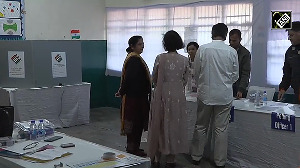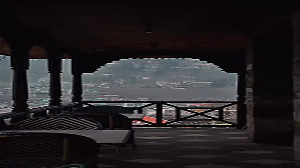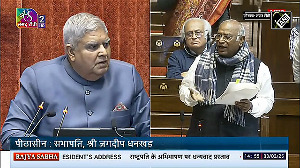
The biannual Aero India 2005 exhibition and air show which began February 9 will probably go down in Indian aviation history as a landmark for a number of reasons.
Exhibition space is over-subscribed despite additional space having been created in anticipation.
American defence and aviation industry giants (who had declined to go to the prestigious Paris air show 18 months ago) will be showcasing their top-of-the-line aircraft and equipment like the F-15 multi-role combat aircraft that has proved itself in numerous wars.
Aero India attracts 300 global firms
Exactly 10 years ago, the United States and India signed the agreement to promote cooperation in defence industry and set up the institutions for this task. Unfortunately, there is little to show so far primarily because of lack of strategic vision on our side. We simply kept repeating the mantra of 'frontier technology' transfer despite knowing that no country easily gives such technologies to even their allies.
Strategic experts are getting around to the conclusion that global power is shifting from the West to East. One of the signs of this shift is the greater salience of defence exhibitions and aviation industry shows in Asia, from Singapore to Dubai and Islamabad. Bangalore stands out well into the sky, because there is a growing market for civil and military aviation systems in India.
India to get first Hawk by 2007
All countries of Asia are focusing on force modernisation essentially in the areas of air power, space and combat support systems like aerial refuelling, electronic jamming, network-centric capabilities and surveillance systems ranging from AWACS to UAVs.
No wonder the US has already approved the export to India of systems like Boeing's CH-47 Chinook transport helicopter, capable of delivering two tons of payload to our posts at 20,000 ft altitude in Siachen.
Companies like Boeing incidentally are extensively involved in designing and producing systems that go to provide network-centric warfare capabilities with tremendous opportunities for collaboration with India with its unmatched strength in information technology.
Airbus eyes India | Boeing bullish on India
Similarly Northrop hopes to market its E-2C Hawkeye airborne early warning aircraft in India and the Indian Navy could vastly extend its early warning reach at a fraction of the costs of the aircraft carrier-MiG 29K system.
At the same time, our civil aviation sector is expanding rapidly. Passenger air traffic is expected to grow annually at 20-percent to reach 50 million by 2010.
Both private and public sector airlines are into aircraft acquisition with a vengeance and are likely to buy or lease nearly 300 airliners in the next 5 years, at an estimated cost of around $11 billion. At least $10 billion would be needed for infrastructure, which is already a weak spot.
In other words, investments in civil aviation would average around Rs 17,000 crores per year. A bulk of this would have to come from abroad with FDI in civil aviation having been raised to 49 percent. This would also open up a huge market for spares and product support for decades to come.
Our interests clearly demand that all this investment should include maximum manufacturing (as well as design and development) capacity being established in the country.
With only two aviation majors -- Boeing and Airbus -- in the business, our leverages are obviously enormous. Our approach has been to seek lowest quotations. But this must change to a criteria based on overall advantage to the country as the deciding parameter.
Offsets hold the key to that. This implies that the manufacturer (which inevitably has the support of the government) offers to set up joint ventures for manufacturing, sales and exports of subsystems and spares capacities in the country acquiring the systems, including buy-back.
Boeing offers buyback in bid for AI deal
Recent cases of offsets have gone to levels where direct offsets amount more in value than the cost of the contract itself. A recent US Commerce Department report indicates that during 1993-2002 a total of 434 US offset agreements with 36 countries, the offset value averaged 92.6 percent of export contract.
Offset criteria, therefore, should be the primary driver of aviation acquisition policy and the basis of advice to the private sector for its participation.
At the moment, the Indian Air Force needs nearly 150 combat aircraft (not to talk of modernisation in other areas) urgently in view of force levels already winding down because of modernisation having been kept on back-burner for years.
Costs have shot up for a variety of reasons and each new aircraft manufactured even in the country would cost nearly Rs. 200 crores to replace what had cost a couple of crores two decades ago.
The Light Combat Aircraft project
Similarly the army and the navy require a lot of aviation assets to remain a modern fighting force. It would be short-sighted to simply seek technology transfer for production of the contracted number of aircraft and not press for off-sets production and export of sub-systems, components and assemblies.
The inevitable high costs of defence would then be partially ameliorated by boosting industrial growth in the country.
The problem is that we are dealing with the high-cost high-technology (civil and military) aviation landscape in India in fragmented and sectoral way.
Such a traditional approach, guided more by turf than a broader vision, with each owner of a segment unconscious of the total picture, unwilling or incapable of thinking of a coordinated and integrated 'national' approach, has to change.
This requires a holistic approach, and since it involves complex areas, high costs, and the involvement of more than 18 departments and agencies of the central government (besides state governments, the private and public sector, etc.) this task is best carried out under the NSC (National Security Council).
India Israel to jointly market light copter
In fact this sort of national policy planning is the core logic for an NSC system to coordinate the actions of various branches and the government and the private sector so that each part is synergised into a holistic national policy.
At the same time, the establishment of a national Aeronautics Commission is long overdue. The sheer scale of investments in the civil and military aviation and aeronautics demands that we set up at the earliest at least a national committee to synergise various aspects of needs, tasks and resources to leverage national aviation/aeronautics development at a faster rate in every aspect.
This in turn would also enhance opportunities for employment in the country, especially for an expanding professional workforce, with long-term benefits for development.
Photograph: Indranil Mukherjee/AFP/Getty Images






 © 2025
© 2025